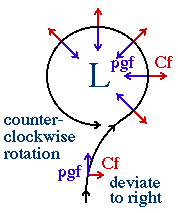Ever wonder why a hurricane, which is a large storm in the northern hemisphere, only ever spins counter clockwise? And why does a Cyclone, a large storm in the southern hemisphere only ever spin clockwise? What could be the reasoning behind this?
It has everything to do with the shape and rotation of the Earth. In fact, if the earth were not spinning, these storms would not even spin at all.
The effect that causes this is the Coriolis effect, which is a pulling effect that constantly, but subtly, pulls east or west on an object that is traveling in the direction of either pole (north-ish or south-ish direction). This pulling on the air mass of a hurricane as the air tries to rush in to the low pressure area causes the spin.
This pulling is caused by the shape of the earth being a sphere. If the earth was any other shape than a sphere, these large storms would not spin in opposite directions 100% of the time. On a rotating sphere, the speed of spin at the equator is much faster than it is near the poles, therefore anything that moves from the area of the equator to either north or south carries with it the inertial forces of the speed of that spin, causing a pull either to the left or to the right, depending on which half of the sphere the object is. If the earth were, say, a spinning disk for example, the coriolis affect would cause all storms to spin the same direction. But because it is a sphere, we get the coriolis pull from two opposite directions dependant on hemisphere, as you would expect.
This is explained very well in this short little youtube clip, even a 10 yr old might be able to understand this:
And here is some further explanation, again explained simply in a way that can be understood, and includes an experiment to try:
http://littleshop.physics.colostate....Hurricanes.pdf
- Home
- Forum
- Chat
- Donate
- What's New?
-
Site Links

-
Avalon Library

-
External Sites

- Solari Report | Catherine Austin Fitts
- The Wall Will Fall | Vanessa Beeley
- Unsafe Space | Keri Smith
- Giza Death Star | Joseph P. Farrell
- The Last American Vagabond
- Caitlin Johnstone
- John Pilger
- Voltaire Network
- Suspicious Observers
- Peak Prosperity | Chris Martenson
- Dark Journalist
- The Black Vault
- Global Research | Michael Chossudovsky
- Corbett Report
- Infowars
- Natural News
- Ice Age Farmer
- Dr. Joseph Mercola
- Childrens Health Defense
- Geoengineering Watch | Dane Wigington
- Truthstream Media
- Unlimited Hangout | Whitney Webb
- Wikileaks index
- Vaccine Impact
- Eva Bartlett (In Gaza blog)
- Scott Ritter
- Redacted (Natalie & Clayton Morris)
- Judging Freedom (Andrew Napolitano)
- Alexander Mercouris
- The Duran
- Simplicius The Thinker






 Reply With Quote
Reply With Quote




Bookmarks